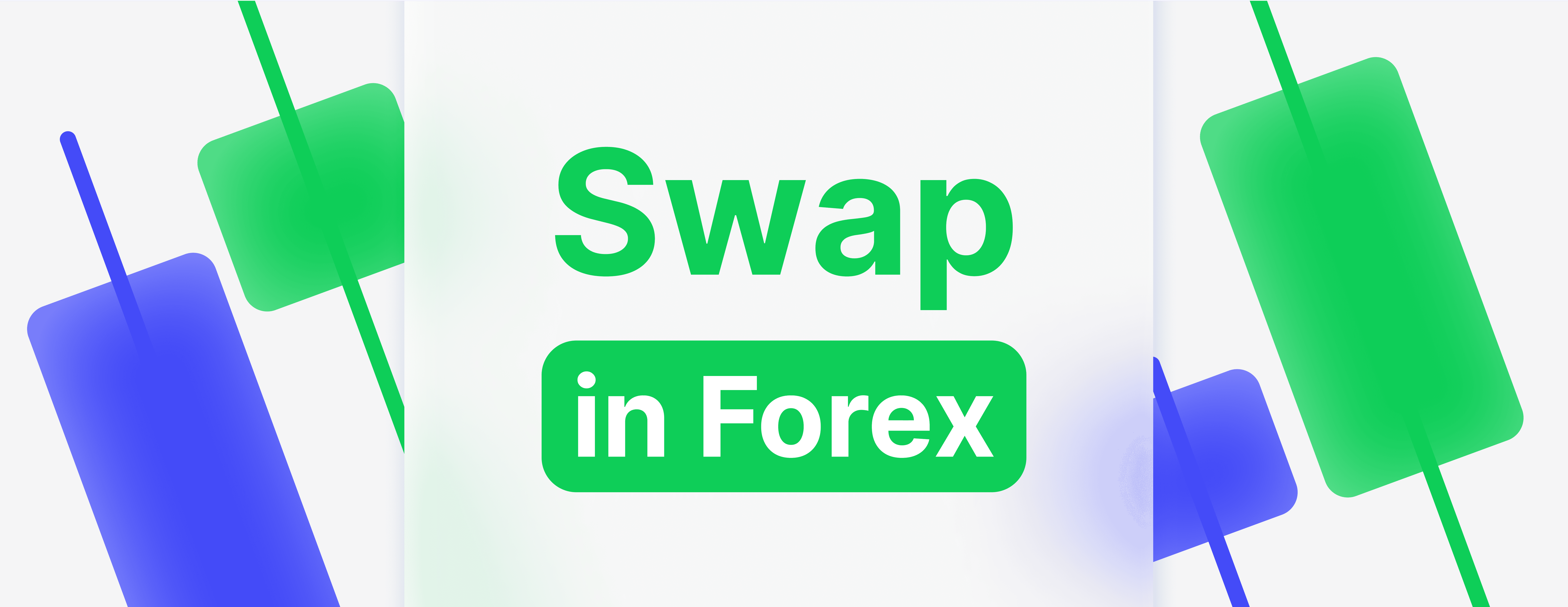Understanding Swap in Forex

 By Tamta Suladze
By Tamta SuladzeTamta is a content writer based in Georgia with five years of experience covering global financial and crypto markets for news outlets, blockchain companies, and crypto businesses. With a background in higher education and a personal interest in crypto investing, she specializes in breaking down complex concepts into easy-to-understand information for new crypto investors. Tamta's writing is both professional and relatable, ensuring her readers gain valuable insight and knowledge.
 By Constantine Belov
By Constantine BelovAs a hard-working, goal-oriented, and well-rounded person, I always strive to do quality work for every job I do. Faced with challenging tasks in life, I have developed the habit of thinking rationally and creatively to solve problems, which not only helps me develop as a person, but also as a professional.
Speaking about my professional activities, I can say that I have always been attracted to the study of foreign languages, which later led me to the study of translation and linguistics. Having great experience as a translator in Russian, English and Spanish, as well as good knowledge in marketing and economy, I successfully mastered the art of copywriting, which became a solid foundation for writing articles in the spheres of Fintech, Financial markets and crypto.

In the 1970s, British firms looked for novel ways to avoid the high taxes placed on British pound currency trades, which led to the birth of swap trading. These early adopters made deals with international counterparts, cleverly avoiding the tax burden by setting up and swapping loans in their respective countries, thereby gaining access to each other's currencies without resorting to a taxable currency exchange.
Although these novel methods laid the groundwork for the modern currency swap, the first formalised swap agreement did not appear until 1981. Fast forward to today, and forex swaps have become indispensable to daily FX operations.
So, let's learn more about what it is and how to use it.
A foreign exchange swap is an interest differential that a trader either earns or pays for holding a currency pair position open overnight.
FX swaps work by crediting or debiting a trader's account at the end of each trading day. A swap is credited if the currency bought has a higher interest rate than the one sold. If the opposite is true, a swap fee is charged.
The calculation of swap rates involves the number of days the position is held, the interest rate differential between the currencies, and the position size.
Several swap trading strategies exist in FX, including carry trade, swap arbitrage, and speculation on interest rate announcements.

In FX trading, the term 'swap' refers to the interest payment a trader either makes or receives for holding a position overnight. Every currency has its associated interest rate set by the respective country's central bank. This interest rate forms the basis for swap calculations in Forex trading.
When traders engage in leveraged trading, they effectively borrow funds to open a position. The swap rate, also known as the rollover interest rate or rollover swap, comes into play here, as it represents the cost or gain from borrowing one currency to buy another during the trading process.
The difference between the swap rates of two currencies is known as the 'carry'. Some traders adopt a 'carry trading' strategy, borrowing in a currency with a low-interest rate and investing in a currency with a high-interest rate to earn interest via the Forex swap.
The concept of an FX swap also incorporates currency pairs. The base currency is listed first in each pair and second in the quote currency. For instance, in the British pound to US dollar (GBP/USD) pair, the pound is the base currency, and the dollar is the quote currency. Every trade entails buying one currency in the pair and selling the other.
The account will be credited with a swap if the purchased currency has a higher interest rate than the sold one. Conversely, a swap will be debited from the account if the purchased currency's interest rate is lower.
Notably, FX swaps apply only when a trade extends beyond a single day. No swap is incurred if a trader opens and closes a position within the same day. If, however, the position remains open for more than a day, a swap gets activated.
The purpose of swaps in FX trading extends beyond mere mechanics. Swaps serve a two-fold purpose. First, they reflect the cost of borrowing one currency and lending another. Since FX transactions often involve leverage, essentially borrowing, borrowing costs are reflected in the swap.
Secondly, swaps are also used to hedge against potential risks associated with fluctuating interest and exchange rates. By locking in specific rates for a given period, traders can mitigate the potential downside of adverse currency movements.
Additionally, swaps in the larger financial market, including interest rates and currency swaps, allow institutions and corporations to manage their debt more efficiently. These instruments can convert liabilities from one currency to another or from a variable interest rate to a fixed rate, providing financial flexibility. Understanding the purpose of swaps can enhance strategic decision-making in trading and broader financial management.
A broad array of participants in the financial markets utilises swaps. At the forefront, traders use swaps as part of their trading strategies, either to earn interest income when the swap is positive or to account for the interest expense when the swap is negative.
Beyond individual traders, large financial institutions such as banks and hedge funds also use swaps. They employ these instruments as a part of their risk management strategies, hedging against interest rate fluctuations and currency movements or simply to profit from their views on such changes.
Furthermore, multinational corporations use currency swaps to mitigate foreign exchange risk associated with their international operations. By doing so, they can secure more favourable borrowing rates and reduce the risk of currency value fluctuations impacting their bottom line.
Lastly, governments and central banks may use swaps to stabilise their domestic currency or to provide liquidity in their financial system.
Swaps come in different forms and types, so let’s break down five major categories:

These are contracts in which two parties agree to exchange future cash flows based on varying interest rates. One party pays a fixed rate, while the other pays a floating rate. This swap type can help institutions manage the risk or speculate on changes in future interest rates.
Currency swaps involve the exchange of principal and interest payments in one currency for equivalent amounts in another. These swaps can provide an economical means for borrowers to access funds in a foreign currency, hedging their exposure to foreign exchange risk.
A company or an individual can exchange debt for equity in a debt-equity swap. This typically occurs when a company wishes to transform its capital structure or default risk by replacing debt with equity. This swap type can be significant for traders if it involves multinational corporations or countries, potentially impacting currency values.
Total return swaps allow the exchange of the total return from a financial asset for a specified interest rate. In essence, one party gets the benefit (or the risk) of a return from a specific asset without actually owning that asset.
A credit default swap is a financial derivative that provides insurance against the risk of a default by a borrower. In Forex markets, credit default swaps can influence the perceived riskiness of investing in a particular country's currency or assets, thus impacting currency values.

Swaps in Forex are charged when a trader maintains an open position beyond the trading day's close, generally at 5 p.m. Eastern Standard Time (EST). This precise moment is known as the "Forex rollover," it marks the end of one trading day and the beginning of the next. It's important to note that the Forex market operates 24 hours a day, five days a week. Hence, the rollover does not correspond to the end of a calendar day.
Any open positions are subject to a swap or rollover fee when the rollover occurs. This fee compensates the broker for the risk and cost of extending the open position into the next trading day. The swap rate is typically calculated using the interest rate differential between the two currencies involved in the pair, although it can also include a handling fee by the broker.
Additionally, Wednesday is considered a triple swap day for the weekend when markets are closed. Swaps are not charged on Saturdays and Sundays, but the banks still calculate interest on any position held over the weekend. To account for this, brokers triple the amount of swap on Wednesdays, which also covers the interest for Saturday and Sunday.

Understanding how to calculate the swap rate in FX trading is vital to managing your trading cost-effectively. The swap rate calculation formula typically involves the interest rate differential between the two currencies of the pair, the position size, and the number of days the position is held.
The formula for calculating the swap rate is as follows:
Swap = (Pip Value) * (Swap Rate) * (Number of Nights) / 10
Here, the 'Pip Value' represents the value of one pip in the currency of your trading account for the particular currency pair. The 'Swap Rate' is the difference between the interest rates of the two traded currencies. The 'Number of Nights' is the duration for which the position is held open.
Let's illustrate this with an example. Suppose you're trading one lot (100,000 units) of EUR/USD, and the interest rate for the European Central Bank (ECB) is 0.25%, while the Federal Reserve (US) rate is 2.5%. The swap rate is -2.25 % (0.25% -2.5 %), assuming you're long on EUR/USD.
If the pip value is $10, and you hold the position open for one night, the swap can be calculated as Swap = $10 * (-0.0225) * 1 / 10 = -$0.225, meaning you'll pay 22.5 cents as a swap fee.
The direction of trade – whether it's a short or long position – significantly influences the swap fee calculation. A trader goes long when they anticipate the base currency to appreciate against the quote currency, while going short indicates the expectation of the base currency depreciating.
Swap fees on long and short positions differ based on the interest rate differential between the two currencies. If you are long on a currency pair, that is, you've bought the base currency, you'll receive the interest on that currency and pay the interest on the quote currency. If the base currency's interest rate is higher than the quote currency's, you'll receive a swap fee (this is known as a positive swap or swap gain). However, if the base currency's interest rate is lower, you'll pay a swap fee (negative or swap loss).
Conversely, when you go short on a currency pair, meaning you've sold the base currency, you'll pay the interest on that currency and receive the interest on the quote currency. You'll receive a swap if the quote currency's interest rate exceeds the base currency's. But if it's lower, you'll pay a swap.
For example, consider you're trading the EUR/USD pair. Suppose the ECB has higher interest rates than the Fed; a long position on EUR/USD will earn a swap, while a short position will pay a swap.
The role of swaps extends beyond just a fee or a credit in Forex trading. Knowledgeable traders can devise strategies to earn profits or hedge risks around these swaps. Here are three notable swap trading strategies.

Swaps can be integral to hedging strategies. Traders can open positions in currency pairs with favourable swap rates in the direction of the trade to offset potential losses if the trade moves against them. Essentially, they're earning swap fees while waiting for the trade to move in a favourable direction. This strategy can benefit long-term trades, where the swap fees can significantly increase.
The most popular swap-oriented strategy is the carry trade. In this strategy, a trader borrows a currency with a low-interest rate (the funding currency) and uses it to purchase a higher interest rate (the target currency). The trader benefits from the interest rate differential, earning swap fees every day the position is held open, provided the exchange rate does not move adversely. However, this strategy carries a significant risk if the exchange rate moves unfavourably, as it can wipe out the profits earned from swap fees.

This strategy exploits the differences in swap rates between brokers. Some brokers may have higher swap rates for a particular currency pair than others. Traders can go long on the pair with the broker offering a higher rate and short on the pair with the broker offering a lower rate, earning the swap difference, assuming there's no change in the currency pair's price. However, this strategy requires careful monitoring of swap rates and can be complex to implement due to potential trade execution delays and transaction costs.
Swaps, a distinctive class of derivative instruments, serve speculative and hedging purposes in Forex trading. Notably, they provide firms with strategic benefits such as avoiding restrictions imposed by regulators, entering new markets, and lowering the cost of currency conversion. The importance of this tool underlines the necessity to understand its functionality, variety, and broader implications within the finance world.
In a forex swap deal, a trader borrows one currency and simultaneously lends another to a second party. The transaction consists of two legs - a spot foreign exchange transaction and a forward foreign exchange transaction. These two transactions are conducted simultaneously and are interconnected, allowing traders to manage risk or speculate on future market movements.
A swap in FX occurs due to the difference in interest rates between the two currencies involved in a pair. When a trader holds a position open overnight, they either pay or receive interest based on the rate differential, referred to as the swap.
The swap rate in forex, or the rollover rate, is the interest paid or received for holding a currency pair position open overnight. It depends on the difference between the interest rates of the two currencies in the pair.
Swaps are paid or charged once a day at the end of the trading day. If the interest rate of the currency bought is higher than the one sold, a swap is credited to the trader's account. Conversely, a swap fee is deducted if the bought currency's interest rate is lower.